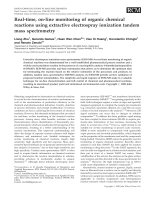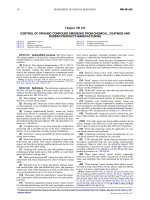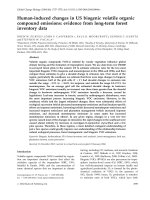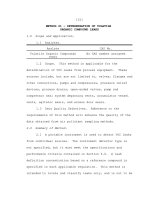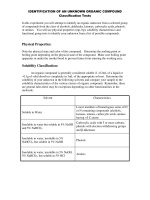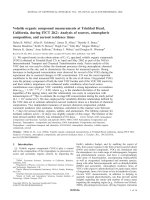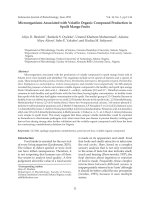Volatile Organic Compound Detection Using Nanostructured Copolymers potx
Bạn đang xem bản rút gọn của tài liệu. Xem và tải ngay bản đầy đủ của tài liệu tại đây (381.12 KB, 5 trang )
Volatile Organic Compound Detection
Using Nanostructured Copolymers
Bo Li,
†
Genevieve Sauve´,
‡
Mihaela C. Iovu,
‡
Malika Jeffries-EL,
‡
Rui Zhang,
‡
Jessica Cooper,
‡
Suresh Santhanam,
†
Lawrence Schultz,
§
Joseph C. Revelli,
|
Aaron G. Kusne,
†
Tomasz Kowalewski,
‡
Jay L. Snyder,
⊥
Lee E. Weiss,
§
Gary K. Fedder,
†
Richard D. McCullough,
‡
and David N. Lambeth*
,†
Electrical and Computer Engineering Department, Chemistry Department, Robotics
Institute, and Chemical Engineering Department, Carnegie Mellon UniVersity,
Pittsburgh, PennsylVania 15213, and National Personal ProtectiVe Technology
Laboratory, National Institute for Occupational Safety and Health, Pittsburgh,
PennsylVania 15236
Received March 3, 2006; Revised Manuscript Received June 2, 2006
ABSTRACT
Regioregular polythiophene-based conductive copolymers with highly crystalline nanostructures are shown to hold considerable promise as
the active layer in volatile organic compound (VOC) chemresistor sensors. While the regioregular polythiophene polymer chain provides a
charge conduction path, its chemical sensing selectivity and sensitivity can be altered either by incorporating a second polymer to form a
block copolymer or by making a random copolymer of polythiophene with different alkyl side chains. The copolymers were exposed to a
variety of VOC vapors, and the electrical conductivity of these copolymers increased or decreased depending upon the polymer composition
and the specific analytes. Measurements were made at room temperature, and the responses were found to be fast and appeared to be
completely reversible. Using various copolymers of polythiophene in a sensor array can provide much better discrimination to various analytes
than existing solid state sensors. Our data strongly indicate that several sensing mechanisms are at play simultaneously, and we briefly
discuss some of them.
The demand for low-cost, low-power, and portable volatile
organic compound (VOC) detection is increasing dramati-
cally due to the need for environment monitoring, space
exploration, homeland security, agriculture, and medical
applications.
1-3
Sensing devices are needed for stand-alone
operation as well as building blocks for sensor network
systems. One of the most difficult challenges is to find
specific materials that have both high sensitivity and good
selectivity to the substances to be detected. An array of
chemical sensors, where each array element is a different
chemically selective material, can potentially provide a
combinatorial response that can be used to not only detect
but also identify specific analytes. While there has been a
lot of success in sensor development for greenhouse gases
(CO
2
,CH
4
,N
2
O, NO, and CO), technology for detection of
VOCs remains a weak point. Existing VOC-sensing materials
includes semiconducting metal oxides,
3-6
conductive poly-
mers (CPs),
7-12
and carbon black-polymer composites.
13,14
Metal oxide materials such as SnO
2
and ZnO, have been
widely used in commercial chemical vapor sensors. A big
drawback of these materials is limited selectivity to various
VOCs and the required high operating temperature (200-
500 °C).
3
Carbon black-polymer composites have also
attracted a lot of research interest as a promising sensing
material system. The different gas-solid partition coefficients
of different polymers to various analytes are believed to
generate swelling-induced conductivity changes between
carbon black particles via a percolation concept.
13
Therefore,
these materials generally show similar responses (increased
resistance) to all tested analytes. Conductive polymers with
alternating single and double carbon-carbon bonds have
recently attracted extensive research interest for sensor
applications.
15,16
Of the conductive polymers, regioregular
poly(3-alkylthiophene)s are very promising due to their high
electrical conductivity and their large number of possible
chemical variants. Indeed, extended chemical selectivity may
be achieved by molecular structure modification. Further-
more, their solution solubility enables the possibility of using
ink-like printing as a batch process for electronic device
fabrication.
17-19
* To whom correspondence may be addressed. E-mail address:
†
Electrical and Computer Engineering Department, Carnegie Mellon
University.
‡
Chemistry Department, Carnegie Mellon University.
§
Robotics Institute, Carnegie Mellon University.
|
Chemical Engineering Department, Carnegie Mellon University.
⊥
National Personal Protective Technology Laboratory, National Institute
for Occupational Safety and Health.
NANO
LETTERS
2006
Vol. 6, No. 8
1598-1602
10.1021/nl060498o CCC: $33.50 © 2006 American Chemical Society
Published on Web 07/14/2006
While it has been demonstrated that these materials have
good sensitivity to polar VOCs, such as alcohols and
acetone,
11,12
their rather poor response to nonpolar analytes
has been viewed as a major drawback. In this report, we
explored two ways to improve the sensor performance of
regioregular polythiophene. The first approach is to add a
second polymer at the end of the polythiophene chain to form
a block copolymer. This second polymer interacts with the
analytes in different ways, thus adding another dimensionality
to the sensing response of the material. The second approach
is to make a random copolymer of polythiophene with
various side chains. Having a mixture of side chains along
the polythiophene backbone, for example, may enable new
polymer conformational changes induced by interactions
between the analytes and side chains. We present new
sensing results for conductive copolymers based on the
polythiophene structure, and we show that the copolymer
structures allow for good sensitivity and selectivity to both
polar and nonpolar VOCs.
The copolymers of regioregular poly(3-hexylthiophene)
(rr-P3HT) were prepared using procedures described else-
where.
20-22
The chemical structures and properties of the
polymers discussed in this work are shown in Table 1. The
regioregular P3HT homopolymer is included in this study
for comparison. PHT-b-PS, PHT-b-PMA, and PHT-b-PBA
are block copolymers of P3HT with different second
blocks: polystyrene, poly(methylacrylate), and poly(n-butyl-
acrylate). PHT-ran-PMT is a copolymer of 3-methylthio-
phene and 3-dodecylhiophene, where the methyl and dodecyl
side chains are randomly distributed throughout the polymer
chain. Atomic force microscopy (AFM) has been used to
characterize the morphology of these polymers when cast
from a slowly evaporating solvent onto an oxidized silicon
substrate. The AFM image for rr-P3HT (Figure 1a) shows
the nanowire morphology. These nanowires were shown to
be one polymer wide, stacked sheets of rr-P3HT with the
polymer backbone aligned perpendicular to the nanowire
axis.
18-19,23
These nanowires were also shown to be highly
crystalline by X-ray crystallography.
23
Nanowire morphol-
ogies were also observed for the block copolymers, where
the nanowire core consists of the rr-P3HT block and the
darker (softer) surrounding region consists of the second
amorphous block. While the images of the rougher surfaces
of our more rapidly dried sensor polymers, prepared by ink
jetting, are not so well defined, it is conjectured that ordering
may exist at least over shorter distances. The presence of
these crystalline nanostructures may help improve sensitivity
and response time in our sensors.
To evaluate the chemical-sensing properties of these
polymers, chemresistors with 200 µm diameter spiral gold
electrodes were fabricated by standard photolithography
processes. The overall length of the gold electrodes is
approximately 4000 µm and the electrode spacing is 3 µm.
The polymers were dissolved in trichlorobenzene at 5 mg/
ml and deposited on the fabricated gold electrodes by an
automated ink-jet system.
24
Advantages of using the high
precision ink-jet printing system include precise control of
localized spot positioning and good repeatability of the
polymer film deposition process. The sensor repeatability
from device to device prepared at the same time appears to
be reasonably good. However, only very limited repeatability
studies have been performed. The polymers were used in
Table 1. Chemical Structures and Properties of Polythiophene-Based Copolymers: 1, Poly(3-hexylthiophene) (P3HT); 2,
Poly(3-hexylthiophene)-b-polystyrene (PHT-b-PS); 3, Poly(3-hexylthiophene)-b-poly(methylacrylate) (PHT-b-PMA); 4,
Poly(hexylthiophene)-b-poly(butylacrylate) (PHT-b-PBA); 5, Poly(3-dodecylthiophene-ran-3-methylthiophene) (PHT-ran-PMT)
a
Mole percentage of PHT composition was determined by
1
H NMR spectroscopy.
b
Number average molecular weight and polydispersity were determined
by gel permeation chromatography with polystyrene as standard.
c
The conductivity measurements were performed on ink jet printed thin films deposited
on Au spiral electrodes with 0.5 V dc voltage applied. Upon the basis of polymer-to-solvent ratios of the jetted solution, the dried film thickness was
estimated to be about 50 nm.
Nano Lett.,
Vol. 6, No. 8, 2006 1599
their pristine stage without any intentional doping process
and via FET device characterization the materials were found
to be p-type semiconductors.
23
The conductivities of the ink-
jetted polymer thin films are shown in Table 1. The sensors
were then tested at room temperature for their chemical
sensing responses to various VOC vapors using 1 L/min pure
nitrogen as a carrier gas. Analyte concentrations ranging from
10 to 3500 ppm (depending on the vapor pressure of the
compound) were introduced into the sensor chamber at 10
min intervals with 10 min exposure times. As examples of
the exposure response, Figure 2 shows the normalized
conductance changes of the polymers for exposure to acetone
and toluene. For acetone exposure, P3HT and PHT-b-PBA
showed a positive response, indicating that the conductivity
increases. PHT-b-PMA and PDDT-ran-PMT showed a
negative response, indicating that the conductivity decreases.
For toluene exposure, P3HT, PHT-b-PBA, and PDDT-ran-
PMT showed a negative response, while PHT-b-PS and PHT-
b-PMA showed positive responses. The sensors demonstrated
a fast, reasonably linear, response and recovered completely
to their original baseline when the analyte vapor was turned
off. Unlike most conductive polymer-based chemical sensors
reported before,
7,12,13
the samples studied here show both
negative and positive response patterns, which enables a
much better VOC vapor discrimination. Table 2 lists the
sensor array responses to 10 different VOC vapors: metha-
nol, ethanol, 2-propanol, acetone, n-hexane, cyclohexane,
methylene chloride, acetonitrile, toluene, and benzene. Dif-
ferent VOC vapors clearly have different response patterns.
To better understand the sensor responses, conduction
mechanisms of the polymers must be conceived, and then
reviewed as to the role of the analytes, as mechanisms that
would induce changes in the conductivity. In the room
temperature regime, polaron hopping conduction is generally
believed to be the charge transportation mechanism inside
the primary, conjugated, polythiophene polymer.
25,26
Mean-
while, according to the morphology shown in Figure 1, there
are two other physical regions, corresponding to conduction
between polymer molecules: (1) conduction within a nano-
structure, such as along the nanowire length and (2)
Figure 1. Tapping mode AFM phase images of polymer thin films: (a) poly(3-hexylthiophene); (b) poly(3-hexylthiophene)-b-polystyrene;
(c) poly(hexylthiophene)-b-poly(butylacrylate); (d) poly(3-hexylthiophene)-b-poly(methylacrylate); (e) poly(3-dodecylthiophene-ran-3-
methylthiophene).
Figure 2. Chemresistor normalized conductivity responses to tested
analytes as a function of time: (a) acetone; (b) toluene. 1 L/min
N
2
was used as carrier gas. Analytes were introduced at 10 min
intervals.
1600
Nano Lett.,
Vol. 6, No. 8, 2006
conduction between nanostrucutres, such as, at the nanowire
boundaries. Therefore, overall conductivity could be strongly
influenced by the degree of crystalline order and by the
nanostructure boundaries. Furthermore, characteristics such
as the planarity (largely affected by the regioregularity) of
the conjugate polymer chain, the length of the polymer chain,
and the side chain composition will influence the overall
conductivity.
18,22,27-32
For a material, for which the conduc-
tivity is limited by the boundary regions, the boundary
material properties such as barrier potential, electronic state
density, and physical length will be of significance.
33
Hence,
for a copolymer, the secondary polymer chemistry plays an
important role. For a chemresistor device, analyte sensitivity
represents a modulation in one, or several, of these conduc-
tion mechanisms. Hence, we can see that there are multiple
possible conduction limiting mechanisms, while physical
insight about the actual sensing mechanisms is still very
limited. In general, from our data we suspect that multiple
mechanisms exist and that multiple mechanisms may occur
simultaneously during an analyte exposure.
Below we attempt to discuss qualitatively different hy-
potheses to represent some sensing mechanisms resulting
from our data. Since all the measurements are at room
temperature and all sensor responses are fully recoverable,
the possibility of chemical reactions between polymer and
analyte molecules can be excluded. First, we notice that
P3HT had positive responses to all polar analytes. The
adsorption of polar analyte on a polymer molecule can
generate a sufficient induced dipole moment to enhance the
electrostatic interaction of the polymer molecules.
34
Thus, a
plausible explanation for the conductivity increasing is that
the induced dipole moment will reduce the average polymer
molecule spacing distance, namely, increasing the density
of states for interchain polaron hopping, resulting in a higher
conductivity.
26
For PHT-b-PS, the responses to acetone and
acetonitrile were negative, and for PHT-b-PMA, the re-
sponses to all polar analytes are negative except for meth-
ylene chloride. This illustrates that adding the second block
introduced other mechanisms that override those of the
homopolymer. For example, acetone is not a solvent for
P3HT, but a solvent for PS and PMA. Hence, the conductiv-
ity decrease of PHT-b-PS and PHT-b-PMA to acetone vapor
is most likely due to the swelling by absorption of acetone
into the PS and PMA block. The decrease in conductivity
for P3HT upon exposure to nonpolar analytes, hexane,
cyclohexane, toluene, and benzene, is most likely due to the
swelling effect. Perhaps the analyte molecules dissolve into
the polymer film and enlarge the spacing between polymer
molecules, resulting in a lower conductivity. Contrary to the
P3HT behavior, we notice that exposure of PHT-b-PS and
PHT-b-PMA by toluene and benzene caused a strong
increase in conductivity. In these cases, toluene and benzene
may interact more strongly with the PS and PMA block than
with the P3HT block, but the mechanism for increased
conductivity is unclear. Meanwhile, the effects of hexane
and cyclohexane are minimal.
In the case of the random copolymer, PDDT-ran-PMT,
the responses were negative for all the vapors except for
methylene chloride. The presence of the shorter methyl side
chains may introduce some space where the analytes can
penetrate and cause a conformational change in the polymer
backbone. Here, most of the analytes have negative re-
sponses, which imply that the polymer backbone twists out
of conjugation with a torsion angle formed between monomer
units, thus reducing electronic coupling between monomers
and the overall conductivity.
32
However, we also notice, from
Figure 1e, that this polymer film has more grain boundaries.
This means that a grain boundary effect can also play a role
to cause a conductivity decrease.
33
Although a conductivity
decrease seems to be the dominant response of PDDT-ran-
PMT, the positive response to methylene chloride further
indicates that multiple mechanism occurs simultaneously
upon analyte exposure. It is clear from these discussions that
film morphology, and, hence, film preparation techniques,
can play a very important role in sensitivity. For this reason,
future sensing studies will involve variations in micro- and
nanostructures.
In summary, we have demonstrated that copolymers of
polythiophene are promising materials for use in VOC vapor
sensors. The sensing results showed new response patterns,
which can greatly enhance the discrimination of VOCs.
Multiple sensing mechanisms involving various physical
interactions between the polymers and analytes are most
likely at play simultaneously, and further experiments are
underway to better identify and understand those mecha-
nisms. Hopefully this work and future studies will illuminate
Table 2. Conductance Response of Copolymers to Various Chemical Vapors
a
∆G/G × 10
-6
chemical vapor µ (D) P3HT PDDT-ran-PMT PHT-b-PS PHT-b-PMA PHT-b-PBA
methanol 1.70 6.39 -1.75 4.45 -1.25 1.76
ethanol 1.69 10.5 -8.05 13.84 -3.72 4.53
2-propanol 1.58 2.79 -5.67 5.79 0.00 1.79
acetone 2.88 1.25 -3.12 -0.76 -1.45 1.04
methylene chloride 1.60 9.25 6.64 4.65 2.36 8.27
acetonitile 3.93 2.48 -2.86 -3.67 -4.02 2.69
toluene 0.38 -1.43 -19.6 20.5 14.6 0.00
benzene 0.00 -1.11 -8.42 5.91 2.45 0.00
hexane 0.00 -1.77 -3.86 0.00 0.00 -1.28
cylcohexane 0.00 -1.94 -4.24 -1.05 0.00 -1.38
a
Listed are measured values of ∆G/G normalized to 1 ppm of each vapor. µ is the dipole moment values of the chemical vapors.
Nano Lett.,
Vol. 6, No. 8, 2006 1601
new design dimensions for conductive polymer based chemi-
cal-sensing materials.
Acknowledgment. We thank the Air Force Office of
Sponsored Research, Award No. F49620-02-1-0359-P00001,
and the National Institute for Occupational Safety and Health
Centers for Disease Control and Prevention, Award No. 200-
2002-00528, for their financial support of this program. (The
findings and conclusions in this report are those of the authors
and do not necessarily represent the views of the National
Institute for Occupational Safety and Health.)
References
(1) Ampuero, S.; Bosset, J. O. Sens. Actuators, B 2003, 94,1-12.
(2) Snow, E. S.; Perkins, F. K.; Houser, E. J.; Badescu, S. C.; Reinecke,
T. L. Science 2005, 307, 1942-1945.
(3) Srivastava, A. K. Sens. Actuators, B 2003, 96,24-37.
(4) Tomchenko, A. A.; Harmer, G. P.; Marquis, B. T.; Allen, J. W. Sens.
Actuators, B 2003, 93, 126-134.
(5) Afridi, M. Y.; Suehle, J. S.; Zaghloul, M. E.; Berning, D. W.; Hefner,
A. R.; Cavicchi, R. E.; Semancik, S.; Montgomery, C. B.; Taylor,
C. J. IEEE Sens. J. 2002, 2, 644-655.
(6) Pasini, P.; Powar, N.; Gutierrez-Osuna, R.; Daunert, S.; Roda, A.
Anal. Bioanal. Chem. 2004, 378,76-83.
(7) Hamilton, S.; Hepher, M. J.; Sommerville, J. Sens. Actuators, B 2005,
107, 424-432.
(8) Crone, B.; Dodabalapur, A.; Gelperin, A.; Torsi, L.; Katz, H. E.;
Lovinger, A. J.; Bao, Z. Appl. Phys. Lett. 2001, 78, 2229-2231.
(9) Janata, J.; Josowicz, M. Nat. Mater. 2003, 2,19-23.
(10) McCullough, R. D.; Sauve´, G.; Li, B.; Jeffries-EL, M.; Santhanam,
S.; Schultz, L.; Zhang, R.; Iovu, M. C.; Cooper, J.; Sreedharan, P.;
Revelli, J. C.; Kusne, A. G.; Kowalewski, T.; Snyder, J. L.; Weiss,
L. E.; Lambeth, D. N.; Fedder, G. K. Proc. SPIE 2005, 5940,28-
34.
(11) Sakurai, Y.; Jung, H S.; Shimanouchi, T.; Inoguchi, T.; Morita, S.;
Kuboi, R.; Natsukawa, K. Sens. Actuators, B 2002, 83, 270-275.
(12) Torsi, L.; Tafuri, A.; Cioffi, N.; Gallazzi, M. C.; Sassella, A.;
Sabbatini, L.; Zambonin, P. G. Sens. Actuators, B 2003, 93, 257-
262.
(13) Lonergan, M. C.; Severin, E. J.; Doleman, B. J.; Beaber, S. A.;
Grubbs, R. H.; Lewis, N. S. Chem. Mater. 1996, 8, 2298-2312.
(14) Ha, S C.; Kim, Y. S.; Yang, Y.; Kim, Y. J.; Cho, S M.; Yang, H.;
Kim, Y. T. Sens. Actuators, B 2005, 105, 549-555.
(15) Dai, L.; Soundarrajan, P.; Kim, T. Pure Appl. Chem. 2002, 74, 1753-
1772.
(16) McQuade, D. T.; Pullen, A. E.; Swager, T. M. Chem. ReV. 2000,
100, 2537-2574.
(17) McCullough, R. D. AdV. Mater. 1998, 10,93-116.
(18) Bao, Z.; Dodabalapur, A.; Lovinger, A. J. Appl. Phys. Lett. 1996,
69, 4108-4110.
(19) Sirringhaus, H.; Tessler, N.; Friend, R. H. Science 1998, 280, 1741-
1744.
(20) Iovu, M. C.; Jeffries-EL, M.; Sheina, E. E.; Cooper, J. R.;
McCullough, R. D. Polymer 2005, 46, 8582-8586.
(21) Iovu, M. C.; Sheina, E. E.; Sauve´, G.; Jeffries-El, M.; Cooper, J. R.;
McCullough, R. D. Polym. Prepr. 2004, 45, 278-279.
(22) McCullough, R. D.; Jayaraman, M. J. Chem. Soc., Chem. Commun.
1995, 2, 135-136.
(23) Zhang, R.; Li, B.; Iovu, M. C.; Jeffries-EL, M.; Sauve´, G.; Copper,
J.; Jia, S.; Tristram-Nagle, S.; Smilgies, D. M.; Lambeth, D. N.;
McCullough, R. D.; Kowalewski, T. J. Am. Chem. Soc. 2006, 128,
3480-3481.
(24) Weiss, L. E.; Schultz, L.; Miller, E. Carnegie Mellon UniVersity Tech.
Rep. 2006, CMU-RI-TR-06-15.
(25) Hutchison, G. R.; Ratner, M. A.; Marks, T. J. J. Am. Chem. Soc.
2005, 127, 2339-2350.
(26) Johansson, E.; Larsson, S. Synth. Met. 2004, 144, 183-191.
(27) Sirringhaus, S.; Brown, P. J.; Friend, R. H.; Nieisen, M. M.;
Bechgaard, K.; Langeveld-Voss, B. M. W.; Spiering, A. J. H.;
Janssen, R. A. J.; Meijer, E. W.; Herwigand, P.; de Leeuw, D. M.
Nature 1999, 401, 685-688.
(28) Babel, A.; Jenekhe, S. A. Synth. Met. 2005, 148, 169-173.
(29) Kline, R. J.; McGehee, M. D.; Kadnikova, E. N.; Liu, J.; Fre´chet, J.
M. J.; Toney, M. F. Macromolecules 2005, 38, 3312-3319.
(30) Ewbank, P. C.; Loewe, R. S.; Zhai, L.; Reddinger, J.; Sauve´, G.;
McCullough, R. D. Tetrahedron 2004, 60, 11269-11275.
(31) McCullough, R. D.; Williams, S. P. J. Am. Chem. Soc. 1993, 115,
11608-11609.
(32) Grozema, F. C.; Duijnen, P. T. V.; Berlin, Y. A.; Ratner, M. A.;
Siebbeles, L. D. A. J. Phys. Chem. B 2002, 106, 7791-7795.
(33) Someya, T.; Katz, H. E.; Gelperin, A.; Lovinger, A. J.; Dodabalapur,
A. Appl. Phys. Lett. 2002, 16, 3079-3081.
(34) Hutchison, G. R.; Ratner, M. A.; Naaman, R.; Marks, T. J. J. Phys.
Chem. B 2001, 105, 2881-2884.
NL060498O
1602
Nano Lett.,
Vol. 6, No. 8, 2006



